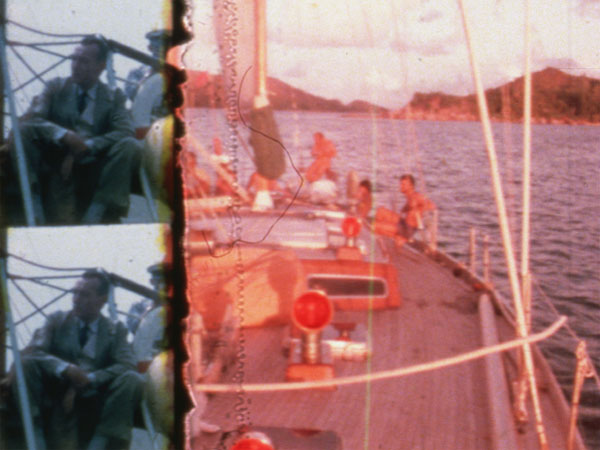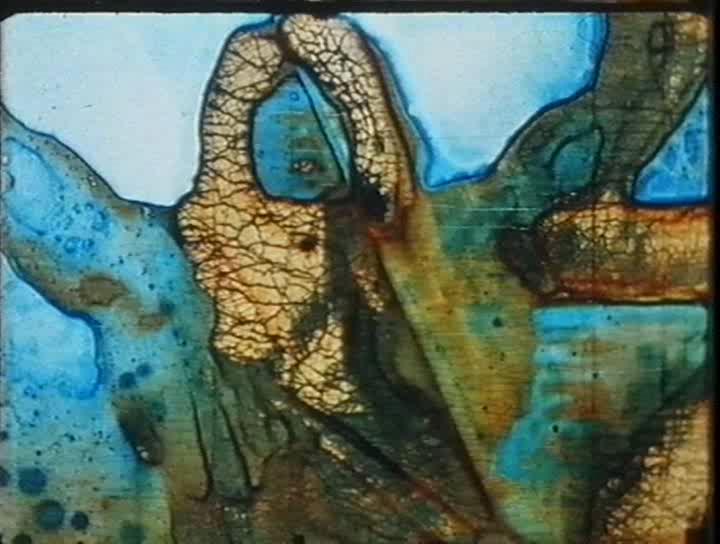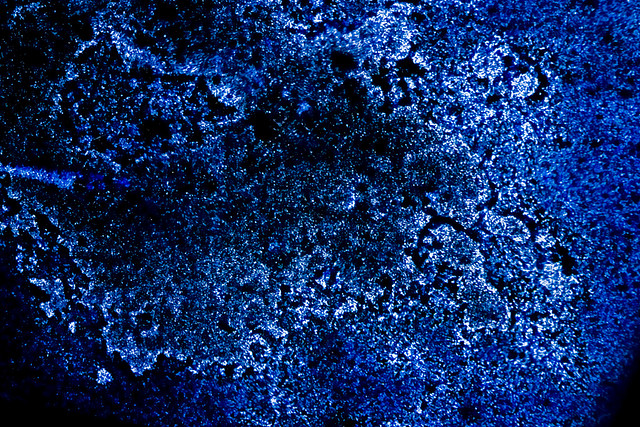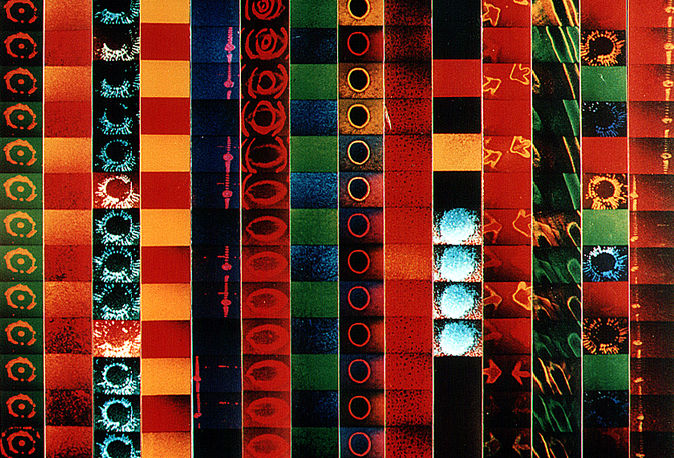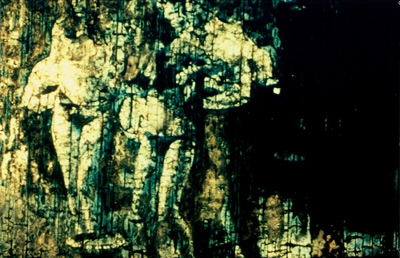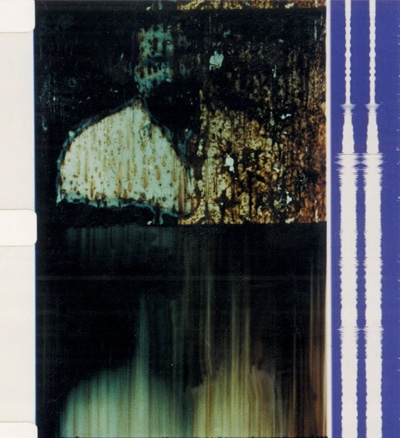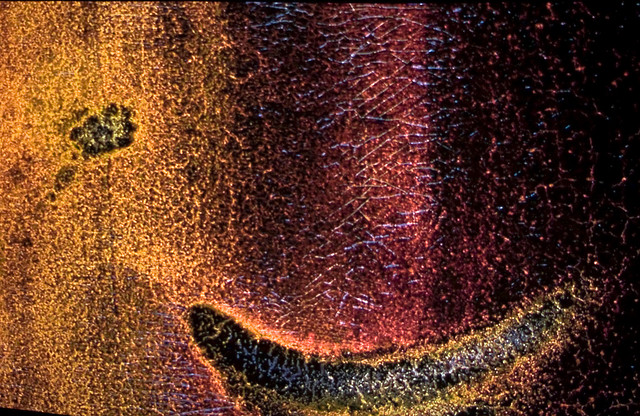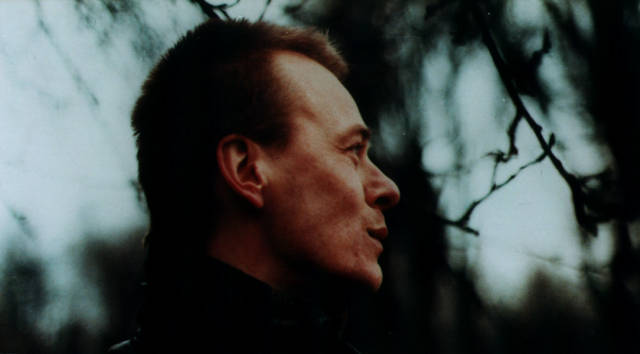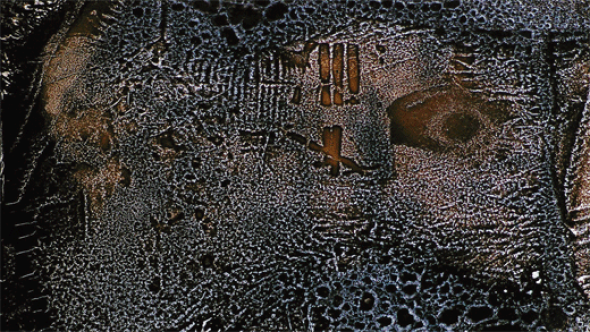
- You Destroy Everything (pdf)
Chemistry and the Alchemy of Colour by Jürgen Reble (1996)
(originally published in Poetique de la Couleur by Nicole Brenez and Miles McKane, Auditorium Du Louvre/Institut de L’Image, Paris 1995. Originally translated from German to French by Marcelo Gandaras. Translated from the French by Zack Stiglicz, 1996 for Millennium Film Journal No. 30/31, Fall 1997)
Schmelzdahin/Color Film/Bacterial Composition
My first experience in understanding how color is layered in film and how these layers might break apart or blend together was very exciting. It involved the film Stadt in Flammen, from 1984. This was a color super-8 copy of a B-movie which had been reduced to nothing but its action sequences. During the same period of time, Schmelzdahin, the group with which I was working, was researching the process of bacterial decomposition in film emulsion. And so, it was only natural that one day I should decide to toss my film into a dank corner of my garden. After a hot, humid summer, I came to gather up the film, which over the course of the summer I’d entirely forgotten. The superimposed layers of color emulsion had split apart and partly mixed together as well. The colors remained very pure and intense, but had departed from their previous form. Indeed, they were laying themselves down upon the old action film to form veritable mosaics of color, remarkably like the stained glass of church windows. This was a really pleasurable experience, and I struggled to make a copy of the film on an optical printer that Schmelzdahin had tried to use in such cases. As it turned out, however, the projector lamp overheated and melted the original. And, sad to say, in related work on the film involving bacterial decomposition, the losses mounted. It is very difficult, indeed impossible, to control such processes. The researcher must apply care and rigor in the choice of materials and everything should be thoughtfully planned.
Schmelzdahin/Color Film/Hands-on Manipulation
Parallel to these endeavors, we were attempting hands-on manipulation of films, our object of study being color negative. We availed ourselves of several means of manipulating film: buffing, punching, carving, chiseling, scraping; we also used sewing machines, knives, hammers, a soldering iron, etc. We began by removing each layer of color, one by one, or we also actually perforated the film. In all of this, the interest that we found in these activities came more from a spirit of discovery than analysis. Projection of the pieces of film manipulated along these lines showed a series of astonishing phenomena. When we subject the film emulsion to regular, rhythmic rubbing with a piece of sandpaper, the depth at which each different color presents itself is revealed. If one scrapes the film even more, the entire emulsion will be scraped away down to the base. A punching gun or sewing machine (with or without thread) lets you make patterned perforations in the emulsion and base. And after a certain degree of experience is acquired, one is able to “dance about” on the image and stitch a precise spot. We didn’t engage in these activities simply in order to man-handle the film strip. What we really wanted was to discover the outermost limits, the boundaries, at which film could no longer be projected. For the most part, the experiments from this stage of our study gave us only fragmentary knowledge.
Schmelzdahin/Color Film/Atmospheric Corrosion
During the years that followed, we conducted rather lengthy investigations into the effects of atmospheric corrosion on film, once again with a preference for color film. We used to set it all up by unwinding hundreds of feet of film — a melange of both our own super-8 as well as various sources of found footage. We would then proceed to hang or drape the film from the branches of trees in my garden. Usually after an intense exposure to sunlight over a period of one to ten months, yellow is the first color to disintegrate. Then, depending on the material, the film loses its red and blues bit by bit. After just about six months the gelatin becomes porous from the effects of wind and rain. During the same period cracks and crevices appear. If you were to visit my garden today, you’d find more or less soiled, spotted and otherwise defiled strips of film in the trees — film accumulated over a period of ten years. A few more years and — nothing. Airborne dust, pollen and dirt come to rest upon the naked base of the film, upon which there used to be images full of color. An act of purification, of a certain sort. It is always amazing and beautiful to see that novel realities come to replace the multicolored illusions and deceptions of film. In 1985, I tossed an entire reel of film into a little pond in the garden. (I believe that it was Ali Baba and the 40 Thieves.) I salvaged the reel a year later and the experience is recounted in Aus Den Algen (1986). Following a narrative commentary, the spectator witnesses the film being fished out of the pond. From the original, only the base survived. Algae cultures had taken up residence, their abodes now stocking the content of the images.
Schmelzdahin/Color Film/Developing
The final years of collaboration with Schmelzdahin were primarily dedicated to the study of those chemical processes that unfold during and after film developing. First of all, we conducted color film experiments involving: changing the hydrogen potential of the color developer, introducing deviations in important temperatures among different baths, brutally interrupting the printing process, and rinsing with chemical baths not permitted by the standard procedure. These operations brought about quite a series of intriguing results such as: the shift of overall color balance to a single color, several false solarizations, alteration in grain, and even the loss of layers of color. In other cases, we divided the material among ourselves, each of us indulging his particular fantasy, each with his own little bottle containing a small amount of extremely concentrated developer. During developing we would shake the bottle irregularly in order to obtain the greatest possible variation in results. More often than not there would be loss of control over both the unfolding of the developing and attempts to repeat a result. However, it was often the “unsuccessful” results that were truly interesting.
Black and White Film/Chemical Treatment
In regard to chemical manipulation, black and white is even more interesting than color film. With the use of toners, one can replace the particles dyed black with metals that capture different colors, for example: sulfur=brown, copper=red-brown, uranium oxide=yellow-brown, or gold=red-orange. White areas remain unchanged. I would rather not elaborate because one can find these recipes in any photography manual; for the most part, these are the same procedures that arose in the first quarter of this century.
At this stage, the most stimulating new results obtained when we tried different toner solutions by interrupting the developing or rinsing with intermediate chemical treatments. Having recourse to developing black and white reversal proved to be very productive. It offered us the possibility of working with the chemistry of the first developer, normally obliterated by bleaching, and of disposing of all the silver particles. Moreover, we determined what substances allow you to dissolve a specific area of the gelatin with more or less precision; we practiced this technique on those parts of the gelatin with a reduced silver density. Coloring the remaining layer of gelatin which had not undergone this treatment, we were able to apply an additional color, freely chosen, to the entirely transparent base. The result is images that seem to be in relief or embossed, whose form and color vary from one project to another, and resemble those historic photographic images originally in black and white that used to be colored by hand.
The incredible richness of possibilities for combining these different techniques promised to immerse us in a truly complex, truly fantastic world, true beyond representation, abandoned on that account by cinematographic history. When we arrived to attend cinema or video festivals, the anachronistic side of our investigations clearly would command our attention. The digital revolution was already wreaking havoc; people were already in it to the extent that they had come to handle images without dirtying their hands, just through the use of brainpower and their fingers. (In Latin, finger is digitus). One pressed a button and the color blue appeared. This seemed to us absurd. We became irrelevant; we represented the Old Guard.
Creation/Unicity/Fungacity
One of the productive outcomes of the period when we experimented with chemical treatments deserves to be highlighted. Particular parts of the collective work Flamethrowers (1989, with Matthias Müller and Owen O’Toole) as well as the opening images of Passion (1992) show a volcanic eruption. In the conventional color film, one such event is decomposed chromatically and the respective parts of color are then replaced, in the three different layers yellow/cyan/magenta, by corresponding dyes. A complete reproduction of the represented object results. In my personal working method, the real world action (of flowing “lava”) is reproduced even in the emulsion itself with the aid of an aggressive bath of bleach. This bath corrodes those parts of the image in which the lava is projected from the crater, the layer of gelatin included. The method of heating thus obtained corresponds exactly to the original action. The primitive energy of the natural phenomenon is preserved and a microcosm is created which materially reproduces the macrocasm. The gelatin remaining on the film is then coated with a deep red color that one obtains in mixing two relatively lightly colored salts together. This coloring occurs chemically — and what makes it particularly interesting is that it progressively disintegrates in contact with light.
Two aspects of this work deserve emphasis: the first is unicity. If one contact prints the images described above onto color stock, this beautiful construction of the mind fades away. A relatively pale, banal copy results or the material is utterly lost. It only becomes interesting again if somebody reworks this material on the optical printer. In this way one gets a new and original work.
The second aspect that deserves emphasis is fungacity. I don’t have a real need to present my work in a form and in states defined for all time. What interests me is the process, evolution, method: the march. So long as we scan the universe that surrounds us, we live in a fleeting world, full of shadows, which reconstitute themselves every single moment. The eye adjusts to these changes and also becomes creative at turns since it projects its interior world on the exterior fugitive universe and continually corrects its interior image. In a dream, the lived, or the real, lives its own (peculiar) life and projects itself. I have a similar experience in my films. The images from which copies were made several years ago have — on the original — profoundly changed, indeed they have, to put it quite bluntly, vanished. And it is this experience of “vanishing” that is truly interesting in the work that I made: to see and behold, to understand how the forms and colors yield to endless change, how they submit to perpetual motion. At the same time, the meanings and the connections among whole ensembles of images transform themselves. Film as an object or a thing, returns to us as a privileged subject; we rediscover it from new tracks, trails, and clues that we begin to pursue — all in order to be continued another time.
Buried Images
Finally, I have arrived at a point where I no longer rinse film in order to remove chemical byproducts that appear during the processing, but instead I let them dry in the emulsion. This gives birth to all sorts of salt crystals. These dry substances have the appearance of many structures and colors and are quite abundant, especially in superimposition. I moisten them with chemical dyes that, upon drying, add even more new structures. I have confirmed as well that the luminous connections are not established by natural light falling on the film, but by light from behind or beneath the image. Therefore I’ve continued my work on a light table. In certain spots, the film becomes so thick that I have a hard time inserting, indeed lodging, it into the optical printer. For composing shots, I help myself to lights with different color temperatures, located in front and behind. Color is a phenomenon that is born in the play between lighting and camera stock.
Alchemy/Philosophy
In the mixed-media film and performance Alchemy, I attempt to bridge the gap between processing and fixing the film. During the projection, a reel of film that has been chemically treated becomes distorted – it decomposes, it rots – bit by bit. In the end, nothing is left but a dance of chemical elements — basic ingredients — and a dance of basic (philosophical) principles as well. The audience is present at a process of formation and decomposition that unfolds in actual, material time. Shapes and colors are born and disappear continually. What one sees seems to be stripped of meaning. One is left understanding that we participate only fugitively in the processes of chemical change, and that beyond a certain point one is little more than the spectator of these phenomena – that is to say – an onlooker, a bystander.
Alchemy constitutes the culminating point in my work. This performance proceeds as a conspiracy between two basic elements, the public and myself. It also proceeds from an emphatic (even categorical) rejection of the logic inherent to museums as well as the world of art, for which its quality as a precious object leaves a work of art to be surrounded, encircled, hemmed in by solicitude — something that is to be preserved. One would name the images that form and vanish in Alchemy as “temporary zones of filmic sensibility.” These zones become impossible to preserve and accumulate despite the materiality of the apparatus. Zones of sensibility demand our attentive care and silence, stillness, reticence, the renunciation of everyday things, and meditation.
Ontology=Zen Material Reality=Nothingness
Film like the representation of material reality will never be fixed or settled and determined once and for all. Color=Form, conceived as an ephemeral phenomenon, leaving is us traces that arouse the remembrance of things past or to come.
Color=Form. So many substantial realities that teach us about the composition and state of the cosmos. Facing the world of media that daily knocks us on the head – the world of media that bores, stuns, pesters and plagues us with copies, canned food and plagiarism – film, apprehended almost as a metabolism, affirms and asserts its human character.
(Kisses to Zack Stiglicz for undertaking this translation with great love and care.)
You Destroy Everything: an interview with Jürgen Reble and Christiane Heuwinkel (1990)
Jürgen Reble is a member of Schmelz dahin along with Jochen Muller and Jochen Lempert. Their three-headed collaborations have produced a remarkable body of work over the past fifteen years, including thirty seven films along with performances, installations and actions. Most of their work has been produced on super-8. With the completion of Stadt im Flammen (City in Flames) in 1984 their work took a new turn, looking to the film material itself to engineer a darkly delicious chemistry that reconnects science and nature, human and animals.
Christiane Heuwinkel is a founding member of the Alte Kinder distribution collective. Unlike the members of Schmelz dahin, who work together to produce films under a common name, Alte Kinder’s four members work together to present their films. Born in 1961, she began art history studies twenty years later in the University of Bielefeld, a small city where all the members of Alte Kinder reside. There she met up with Matthias Müller who encouraged her to participate in the University’s film workshop. Along with Muller and six others they formed Alte Kinder in 1985. Heuwinkel began her filmwork in 1983, with Matthias Müller. These close friends have produced five films together. Two other films, three-minute anyone-can-do-it send ups of Gone with the Wind and Rear Window, have been made in collaboration with another member of the group, Maija-Lene Rettig. Her most recent film, Welcome You, was made for Owen O’Toole’s Filmmaker’s Almanac. Heuwinkel works exclusively in super-8 and is largely self financed.
MH: Maybe you could both introduce yourselves.
CH: My name is Christiane Heuwinkel. I’m a filmmaker and work in a distribution co-op called Alte Kinder, begun four years ago. I’ve worked for nine years in film and only in super-8. After a while I got to know some other filmmakers who worked and lived in the same city, Bielefeld, and we thought as there is no distribution system for super-8 films in Germany, we should start one. At first we distributed only our own films, eight members’ work, and now we are four. After a while we took on other films we knew and liked, for instance films by Schmelz dahin, and the new idea is to get more films by others.
JR: My name is Jürgen Reble. I live in Bonn. I’ve worked since 1983 together with two other people under the name Schmelz dahin which means melt away. We tried to work in a group together to change our materials and our ideas, and published films not with our names but only with the name of the group.
MH: Why?
JR: I think it was a kind of protection because we had no experience with public presentations. Then it was no so hard when someone says, “Forget it. It’s shit. Stop making films.’
MH: Why the name Schmelz dahin?
JR: After one of our first screenings some people said ‘schmelz dahin.’ That was the only reaction. We work a lot with the material, treating it in different ways. For instance, we put so much light on he film that it burns down while it is projected, and this is also a schmelz dahin, a melt away of the material. So this was a protest/process of five or six years in which we published a lot of short films.
MH: Jochen said you’ve been working together for twelve years.
JR: Yes, with Jochen, but there’s a third person whose been with us only since 1983 when we became more serious. Before 1983 were just the first experiments. I wouldn’t publish these today, they’re not important to the development of our work.
MH: What kind of films were they?
JR: Joke films. funny animated films without serious ideas, serious plans.
MH: Did that change when the third person came in?
JR: Not directly. In 1983-4 we began to work more intensively on the material. In 1984 we made an important film called Stadt im Flammen (City in Flames). This is a very strange, compact film because there’s only one scene, the treatment of the material, and the form is very strong. This is for me the first film, we made it for publication. City in Flames was a very cheap B-movie, a super-8 digest of a terrible film which contained only action scenes and catastrophes. I buried it in a wet place in the garden and forgot it for six months and bacteria spread its different layers. The whole film was disturbed by bacteria and there emerged something completely different…
Then I threaded it into a sewing machine to make holes into the film, then copied it onto an optical printer. I took four frames from each single frame of the original and heated it so much that it began to melt. There is no original left, it’s lost to its copy. Then Jochen came and we made the sound together. He had this idea of hitting his chest while droning and it was a good combination. Stadt im Flammen was like a structural film, one idea which demonstrates a process. Later we were more interested in montage, to combine themes of different material and open the film in a more analytic way to build up some interesting…
CH: Levels of association in the film.
MH: There was a shift ten in the way you made films, from the costume drama joke films to a three-sided collaboration focussed on the materials. Why this shift?
JR: We had not much discussion about this, because if someone did something it was accepted by the other two. Most of the films were not made with three but just two, or one made the image and one the sound. In the search to find something new in the material it was difficult for us to have an idea or treatment and only to work on that idea. It was also important to make new experiences, possibilities, change. With normal processes, if you give the film to the lab, you always get the same result. If you work on the material you have a lot of possibilities to bring it to a new form. It’s not so important to arrange the world around me. for me it’s more interesting to take it as it is and make the rest through development.
MH: The film has both the life of its original, the calling of origin, but also the scars of this disfigurement, of its remaking. It’s very rare that groups evolve in fringe film: Schmelz dahin makes work together, and Alte Kinder distributes together.
CH: Yes, we have a completely different way of making films. For us it was clear that everyone wanted to make his/her own films but distribute them together. Even if we help each other in our making, the authorship is clear. I’ve worked sometimes with a friend of mine, Matthias Muller. We made our first film together at school. Matthias studied art and film, I studied German language and history. Apart from this we worked in film together. Then at festivals we came to know some others who also made films in Bielefeld so we wondered why we went separately to these festivals. Why don’t we go together? So we began distribution, showing films in several places.
MH: Is it difficult to show super-8?
CH: Some of the Kommunale Kinos show it but often we have to bring our own projector. It’s beginning a little bit with art galleries. When we started in 1984 there was a terrible prejudice against super-8, they claimed it was for dilettantes and we said, ‘We are dilettantes and we are good and we will show you.’ At the beginning it was not so easy to show our films, but after awhile people knew us, we got a kind of name. They could read about our films and then we got some small prizes, this was something to show them, that we work with super-8 not only as amateurs but because we love this material. After our films shows we always discuss how super-8 has a lot of possibilities you don’t have with other materials (16mm or video). We’ve shown in festivals, small art galleries, Kommunale Kinos, youth centres, drop in centres, film clubs, cafes, bars…
JR: I think you can find fourty places in Germany to tour. We did it last year.
CH: This is a problem. If you want to make film you can’t distribute it at the same time; it’s too much work. So we set up some dates, say two in a month, then next month nothing, then four shows. It’s too difficult to organize a real tour going from town to town for a month. But for instance when another member, Maija-Lene Rettig, went to London she organized four dates there. A year later she was invited back by the Goethe Institute in England. Then the leader of the GI in London told the GI in Israel that I wanted to show films there and they supported the trip. It’s a network that develops.
MH: But always dependent on someone accompanying the films?
CH: This is the central problem. From the beginning we always showed our films accompanied by one or two of the filmmakers. One introduces, the other projects. Afterwards we discuss. This is the central point, that you have a person who can speak about the film so they’re not anonymous.
MH: I work for a distribution company and it’s completely different. We sent out hundreds of films each year.
JR: To festivals?
MH: No, there’s too many. They go mostly to schools. This is a big difference in our two countries, that we could never send someone along with our films, but you show work in a public way, outside the university, and as a result your work is much less academic. Why don’t you show your work in the schools as well? Many people teach courses in experimental film.
JR: Students account for maybe half the audience here at the Osnabrück Festival and at many others, so they see the work.
MH: Is there a relation between your work and mainstream media? Schmelz dahin uses a lot of ready-made images.
JR: From other movies. There’s already too many images produced. In Germany there’s three million photographs taken in one year. I think it’s possible to take what already exists and make something new.
CH: And try to make it productive for our work. A friend of ours, a former member of Alte Kinder, worked only with news shows, and put the material in new contexts and made his own political stories out of them. Or you can have your own material and use it like TV images, photographing in super-8, refilming in video, then rephotographing in super-8, a working through of generations which bears the trace of each of its stages. The image itself reveals a history.
MH: Some argue that the fringe is a small scene with its own codes, its own ways of making. Some have said that the Osnabrück festival isn’t exciting because so much of this new work looks old.
JR: I think there’s some things that are important only for yourself. For the people who organize the festivals they need to choose only the really new films.
MH: How does the Schmelz dahin group decide whether a film’s finished or not?
JR: Sometimes it takes one or two years after it’s finished, it’s a difficult question. A lot of people should realize what they publish and what they don’t. For instance Brakhage has produced a lot of films but not every film is important to show to the public. It would be better to have a little bit of self-control.
CH: I think this is something you decide for reach case. When you see the work of Schmelz dahin as a whole you see some works are more important than others. German films are quite different from one another; when you see many experimental films you can say, “I think this film comes from Berlin.’
MH: How can you tell a film is from Berlin?
CH: Some years ago in every Berlin film it was fashionable to show the wall and policemen on both sides, the Reichstag and the Olympia stadium, the fascist architecture. Then there were black and white films that were very flat and grey. This was another kind of fashion. There are some special themes or ways of doing it within each film group of school. For instance in the art school in Bremen where Klaus Telscher teaches they develop their own material. You can say, ‘I think this film is made in Bremen.’ But this isn’t so important because there’s so many places to work.
JR (to CH): In The Flamethrowers you’re working as a group, but everyone has their own style. I think the most important point is your name, it’s your common point.
MH: Can you describe The Flamethrowers?
CH: Owen O’Toole sent us three super-8 film reels which were made from the first independent film in India. He wrote us, ‘Do what you want with this material, use it as footage for your own work.’ We imagined showing them altogether, on three screens. Then we responded with our own associations, everyone had a different idea. Two or three days later we realized our films together. We made a second series of three reels. Then we thought that Schmelz dahin might be interested to make the third generation, so we sent them the material. We showed it in Bielefeld as a triple projection, first the three reels by Owen, then Alte Kinder, then Schmelz dahin, but it was very complicated to find three projectors, so we made a kind of trailer which combines the triple projections and pictures from each one. This is something we show at the moment, but we’ll try to blow it up to 35mm.
JR: We tried to make a third part, taking some of the images that Owen O’Toole and Alte Kinder used and joining them with our own. One condition was to make black and white films, as all the other films were black and white, which was the first time for us, so we tried to find a new method to apply colour to black and white. We found a possibility and made the third part in red and black and white. On the optical printer we shot some stills and repeats of other parts and then introduced our own material.
CH: What was special about the material Owen sent was that it was almost destroyed. You see traditional Indian scenes, but because the material was heated during projection…
JR: Owen saw the film in a regular cinema, and the projectionist must have been sleeping while the film burned away. He asked if he could have it because it couldn’t be used any more. Then he made three reels of this material.
CH: When we saw these great holes within the frame we made an association with pearls, so we filmed a woman lying on the ground with pearls running down her face and body. Sometimes you see the same image in each projector, sometimes with a delay in time, sometimes no picture left and right, only in the middle. Each projector is an instrument. Three chapters. As we watch it we watch the journey of the film through time.
MH: Can you describe the films you made after Stadt im Flammen?
JR: We work very closely with our material. We have an archive from which we derive our ideas, our process of working. We have our own inclinations, our relation to science and nature, and on the other hand we listen, we learn from the films. Many things exist by chance, but it’s a selected chance. If you make a film in your head first, you could never imagine these films.
CH: When we saw Owen’s footage we thought this must be made by Schmelz dahin! You always use animals as commentators to things which happen on the screen. On the soundtrack you often use short bits of found footage. You’re consistent in working on the chemical level of film and working with very heterogeneous material which is combined in new ways.
MH: Your films are very aggressive.
CH: Yes Jûrgen, because you destroy. You destroy the film material, you destroy the rat, and in the last film you destroyed your mother.
MH: In Rumpelstilzchen?
CH: You see a woman pushing a tractor, it was his mother.
JR: And the last part was my son.
CH: In another film you showed your father.
JR: My father made some home movies, this is part of the archive now (laughs). But it’s not only destruction, also reconstruction, like Germany.
MH: There seems a kind of conflict between you and your archive, that it needs to be forced, melted, burned, scarred, to show what’s there, undergo these trials…
JR: I live very close to the material. My trees are full of films. I hang them and leave them there for two or three years.
CH: Schmelz dahin made a film which is called Out of the Algae where they stored their film in a fish tank for several months…
JR: Years.
CH: (laughs) Sorry.
JR: Sometimes there are no images on the film any more but after one or two years the algae is settled into the emulsion of the film.
MH: What kind of footage was it?
JR: Old footage which wasn’t important. At the same time we made a narrative section, a figure who demonstrates what’s going on with the materials. Between 1983-87 we did a lot of biological treatments, but now we work more with chemicals.
MH: Do you process all your own footage?
JR: Yes and we made our own prints. This is the possibility to make real independent films, which is why I’m still working on super-8.
MH: What does one of your films cost?
JR: $70, and another $70 for the print. To blow it up is more but I don’t know if this is necessary because in Germany there’s many possibilities to show super-8. I think in North America it’s different.
CH: For me I’ll go on in super-8. With our last film, Epilog, we tried many different things while working, rethinking possibilities of refilming for instance. Three minutes only costs us $10 so it doesn’t matter if it comes out with nothing on it. 16mm is too expensive to play with. Our cameras are very small, you can carry them everywhere with you and be spontaneous.
MH: Do you take the camera with you all the time?
CH: Not at the moment but I did when I was in Israel. I couldn’t anything at first because the situation was so strange. After two months I began to shoot, using the camera as a diary. When I got back I had many film reels, but the film I finally made for Owen O’Toole’s Filmmakers Almanac is just four minutes long.
MH: Shooting in super-8 seems very immediate but the editing can be difficult with such small pieces.
CH: It changes from film to film. In Israel I wanted to make an impression of my changing emotions, and had the problem of finding an adequate soundtrack, a commentary on my inner conflict. Other films are very planned, for one I made special drawings, a storyboard.
MH: Jürgen, can you talk about how you use the camera? After you’ve been picking through your archive do you decide as a group to go out and shoot.
JR: It’s similar to what Christiane says, it’s a form if diary, of watching your environment. Often I shoot images and don’t know why, it’s just material. It’s not often that I search for material in a specific way.
MH: Do you catalogue your archive?
JR: Most of the images are in my head.
MH: How big is the archive?
JR: It changes. To start a film I need about ten hours of material. At times I’m just collecting, I don’t know why. Then if I have enough I start to treat the material and make different copies and processes. The new film I’m working on is more selective material and also longer, but that’s another story.
MH: Will that be a Schmelz dahin film?
JR: We’re not working together.
CH: It’s a kind of divorce.
JR: If I’m working with other people it’s important to live close to them and to have contact and experiences. Paul is living three hundred kilometres away so I can’t meet him, and the Jochem has been travelling for the last half year so there’s no chance to continue.
Postscript: Excerpts of a letter from Christiane Heuwinkel
22.1.90
Dear Mike
Thank you very much for your letter and the interview… When Matthias got the letter I was in Munich, and when I came home I had lots of work which could not be postponed (just jobs to earn some money, nothing serious), so I put off what is really important and gave preference to filthy lucre. Foolish!… I think it is not mere accident that in both interviews my remarks often refer to co-productions (with Matthias) or the work of the other interlocutor. In contrast to Matthias or Schmelz dahin, for instance, I am no full-time film artist, more or less an amateur. And in the last two years, when filming became more serious and also a way for them to earn their living, my interests changed from practice to theory. Maybe because I am not so creative. I started working at the university after finishing my first exam and now begin work in a dissertation about early film criticism in German newspapers. It’s not that I gave up filming, but at the moment there is other work to be done! A strange situation when Maija, Thomas and Matthias had the premiere of their new films and I stood there with nothing in my hands! So sometimes my feelings change-from feeling myself as a part of Alte Kinder and then of drifting away. Maybe this has to do with our problems of finding time for an interview. Sometimes I have the tendency to draw back, and later I regret it…
Hope I will hear from you soon, Christiane!
Schmelz dahin Filmography
1975-78 Scholli’s True (10 minutes); Cutaway (8 minutes); Die Goldenen Sechszigerr (19 minutes)
1979 Was ich bin (15 minutes)
1983 Augentruffel (5 minutes); Munzesheim (6 minutes); Sparlich gelungener Wurf mit boseum Loffel (3 minutes); Der Meister (3 minutes); 5045’N 79’E (4 minutes); English for today (3 minutes); Dallas (5 minutes); Bildserie (10 minutes); Such nach verlorenen Selen (6 minutes)
1984 Rudi Dofert (15 minutes); In diep Hust (6 minutes); Stadt im Flammen (6 minutes); Pelshing (1.7 minutes); Die lange Nacht der Kaiserpinguine (4 minutes); Weltenemfanger (8 minutes)
1985 Feuerland is abgebrannt (6 minutes); Trompetentierchen (13 minutes); Der Mieter (3 minutes)
1986 Mauser (13 minutes); Onkelschrompel (7 minutes); E.R. (6 minutes); Sius wie jod, issed ab sernit (6 minutes); eis (7 minutes) Aus den Algen (10 minutes); Der Empfindliche (5 minutes)
1987 Hab ich gesehn, der General (15 minutes)
1988 Weisspfennig (6 minutes); Krepl (8 minutes); Schildmayer Darlaten (12 minutes)
1989 Rumpelstilzchen (12 minutes); XXX (19 minutes)
Christiane Heuwinkel Filmography
1983 Nature Morte 26 minutes (with Mathias Müller); Rapunzl 15 minutes (with Mathias Müller)
1983/4 Wanderer im Nebelmeer 17 minutes (with Mathias Müller)
1984 Rear Window 3 minutes (with Maija-Lene Rettig)
1985 Gone with the Wind 3 minutes (with Maija-Lene Rettig); Danke 2 minutes (with Mathias Müller); Die Schone Landschaft 7 minutes
1986/7 Epilog 16 minutes (with Mathias Müller)
1988/89 Welcome You 4 minutes (for the Filmmakers Almanac)
(Originally published in The Independent Eye Vol. 11 No. 2/3 Spring 1990)
